SouthCoast Wind Staff Field Queries About Project’s Impact on Sea Life
Public information session held at the Common Fence Point community center
July 27, 2023
PORTSMOUTH, R.I. — A few came to ask questions and hear answers. Some came to raise their voices on behalf of migrating fish and seafloor life. Several came to shake anti-offshore wind placards and demand the quick and widespread construction of nuclear fusion plants.
One anti-wind picketer said global warming might be aggravated by researchers sticking antennae into the stratosphere, and suggested one solution for the heated planet was conservation, specifically to use leaf rakes instead of leaf blowers and to open windows in summer instead of turning on air conditioning.
The July 25 occasion was a free-form information session by staff members of the SouthCoast Wind project in Portsmouth, one of the communities most aggrieved by a plan to build up to 149 wind turbines 30 miles south of Martha’s Vineyard.
About 20 to 25 members of the public rambled in and around the Common Fence Point community center during the three-hour period, viewing displays packed with data and chatting with SouthCoast Wind community liaisons. About 15 opponents of the project picketed out front for about an hour before disbanding.
The answer can never be known, but the public turnout may have been far higher if the SouthCoast Wind project were not already reeling from one self-inflicted and one external gut punch that, at best, will delay the proposed project well into next year.
Last October, the developers said they would step away from its signed power-purchase agreements (PPAs) with Massachusetts, saying the proposed wind facility may be not economically viable under the PPAs because of unanticipated high costs due to inflation, supply chain problems, and the war in Ukraine. Kelsey Perry, community liaison coordinator, said SouthCoast intends to submit a new bid for a PPA when bidding opens in January, with hopes that an agreement for the project will be awarded to SouthCoast by late next spring.
The second blow was a decision by the Rhode Island Energy Facility Siting Board this month that the board would take no action on the project’s application until Oct. 1, 2024, or until the developer obtains new financing agreements for its proposed wind facility.
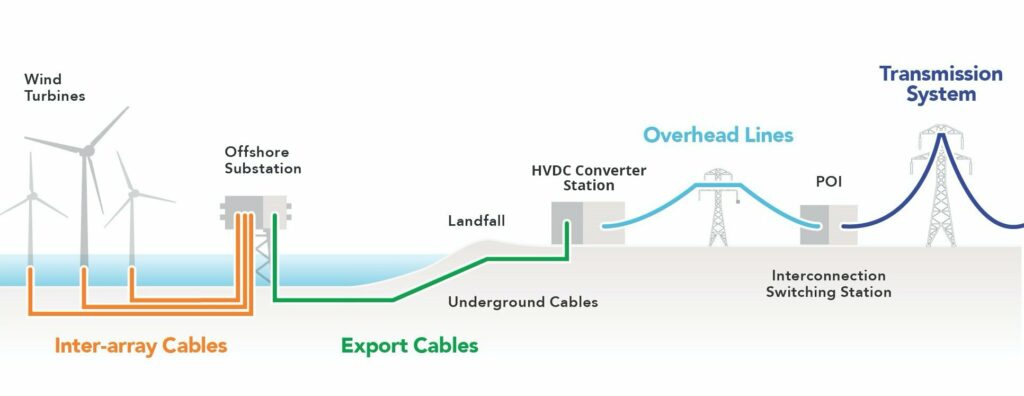
The 2,400-megawatt project is proposed for 127,000 acres in federal waters and it is intended to provide power to Massachusetts. But developers want to install one of two export cables that carry power from the turbines to shore in Rhode Island waters along the bottom of the Sakonnet River. The cable would run underground across Portsmouth before exiting in Mount Hope Bay to meet the grid at Brayton Point in Somerset, Mass. The second of the two export cables would make land in Falmouth, on Cape Cod.
Situating the cable in Ocean State waters brings Rhode Island government into the mix of permits and approvals, involving the state’s Energy Facility Siting Board and the Coastal Resources Management Council.
Plans for routing and burying the cable across 2 miles in Portsmouth, according to SouthCoast Wind, include following existing roads; using routes to the northeast to avoid dense residential neighborhoods; using rolling lane closures; and limiting construction to the offseason to the greatest extent possible.
People who came into the community center and those who picketed outside raised familiar questions and objections to the project, touching upon impact on fisheries and the seafloor and the potential for pollution.
Portsmouth resident Kathy Matsch said she feared the electricity-bearing cables to be buried in the floor of the Sakonnet River would harm sea life and heat up the oceans.
In a statement, the developer replied that “SouthCoast Wind’s transmission cables will not vibrate. And, as required by regulation, the HVDC cables will be completely shielded and buried an average of six feet below the sea floor minimizing any potential impact from magnetic fields.” The company added there is no anticipated thermal effects on the seafloor itself or to species living in the surrounding water column.
Matsch also asked about the possibility of an oil spill from the turbines, saying she had seen a YouTube video in which a wind turbine “blew a gasket” and sprayed oil into the air.
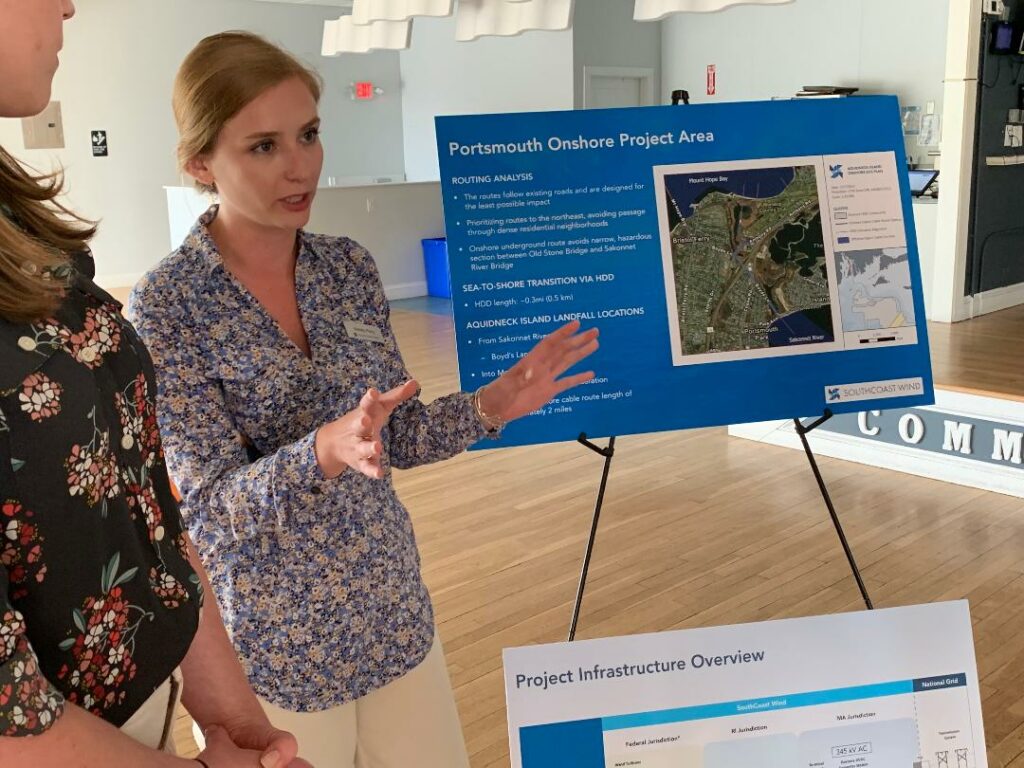
On that question, SouthCoast responded, “Wind turbine generators require a fixed amount of oil within the nacelle assembly for standard mechanical purposes such as lubrication, cooling, and hydraulics. SouthCoast Wind will use wind turbine generators equipped with sensors to automatically detect a loss in fluid pressure or an increase in fluid temperature, allowing them to be shut down in case of a fluid leak. Further, the turbines will be self-containing so any leak would be directed to collection areas within the turbine structure.”
Matsch also asked about decommissioning of the turbines at the end of their approximate 30-year life span, and whether the turbines would be left to rust in the ocean.
On the topic of decommissioning, SouthCoast noted it “submitted a conceptual decommissioning plan as part of its Construction and Operations Plan. SouthCoast Wind would have to achieve complete decommissioning (removal of facilities, projects, cables, and obstructions and clear the seabed of all obstructions) within two years of termination of the lease and either reuse, recycle, or responsibly dispose of all materials removed.
“The decommissioning plan will continue to be reviewed over the operating life of the project to incorporate new advancements in marine science and engineering, as well as lessons learned from the offshore wind industry and other offshore operations. BOEM will review and may approve, approve with conditions, or disapprove the final decommissioning plan.”
Also, SouthCoast would bear the cost of decommissioning the facility. The company said, “Prior to construction, SouthCoast Wind must submit a bond (or another form of financial assurance) that would be held by the U.S. government to cover the cost of decommissioning the entire facility.”
A woman asked SouthCoast reps, “Who benefits from this? Not Rhode Island.” A representative said the 2,400-megawatt project would feed electricity into a New England-wide regional grid, ISO New England, that supplies power to all New England states. “There are a lot of big energy facilities [power plants] that are about to come offline,” the rep said. “We need new replacement energy sources.”
The murmurs of conversation were enlivened by the arrival of John Kourtesis, a burly, tanned dragger fisherman who lives in Tiverton and has fished, he said, from North Carolina to the Gulf of Maine. Sweeping his hand across the map of the project and the adjacent southern New England coastline, Kourtesis declared that leasing the ocean bottom should not be done “as a matter of principle. This is our national park.”
Kourtesis also argued that the federally approved wind lease area is directly between ocean canyons to the south, where many species of fish live, and several waterbodies — Narragansett and Buzzard’s bays and Long Island Sound — to which fish migrate every year, usually in the spring, to spawn. Kourtesis said he is convinced the turbines and cables would disrupt migration behavior.
Outdoors, anti-wind protester Frank Haggerty objected to the developers’ choice to run export cables up the Sakonnet River and underground across Portsmouth. He called this the “unplanned” method that is cheaper for developers but disruptive to small seaside communities. In contrast, Haggerty said the “planned” method would be to run undersea cables directly into big coastal cities with roads and industrial development already near the shore. He mentioned Westport, Mass., Boston, and Hartford.
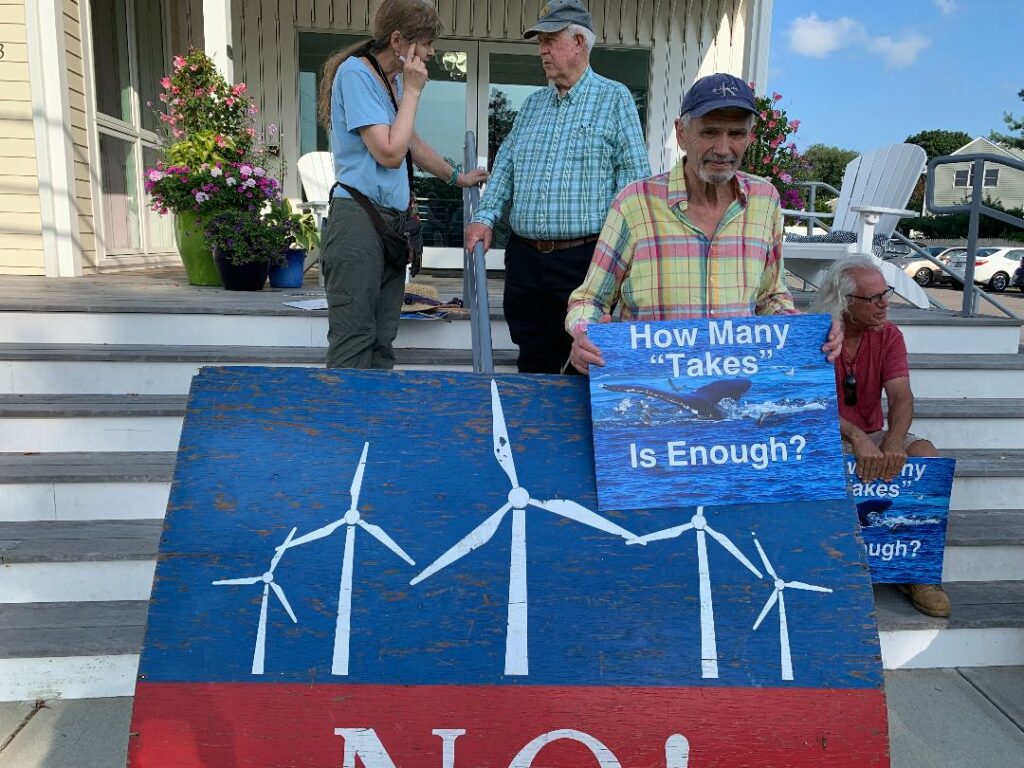
Haggerty had no answer when he was reminded that getting cable to Hartford, in the geographical center of Connecticut, would also disrupt coastal towns. “In Connecticut there is a major city every 20 to 25 miles,” chimed in David Moriarty, another protester.
Several protesters touted the idea of getting cleaner energy from small nuclear power plants. “They come in on tractor trailers,” one man declared. Asked about the visceral negative reaction and fear that the public has in general to any mention of nuclear power, the group replied with a shrug.
Tom Clemow, a Rhode Island supporter of offshore wind, has created a Facebook group that discusses information and misinformation about offshore wind.
One of the SouthCoast Wind representatives, Lawrence Mott, a transmission specialist, said the interactions indoors were basically fruitful. He said he had a long and worthwhile conversation with a man about power transmission. People “have heard tidbits about SouthCoast Wind,” Mott said. “Once we explained the project they had a much more well-rounded picture of what we are planning to do. They came in here saying they had heard about [the project] but didn’t know what the fuss was about. They went out saying, ‘That seems rational.’”
Kelly Smith, manager of the onshore part of the project, said, “People didn’t come in here with the [understanding] that these turbines are 30 miles off the coast of Martha’s Vineyard. They didn’t know we were burying the cable, which is something that’s been done for many, many years.”

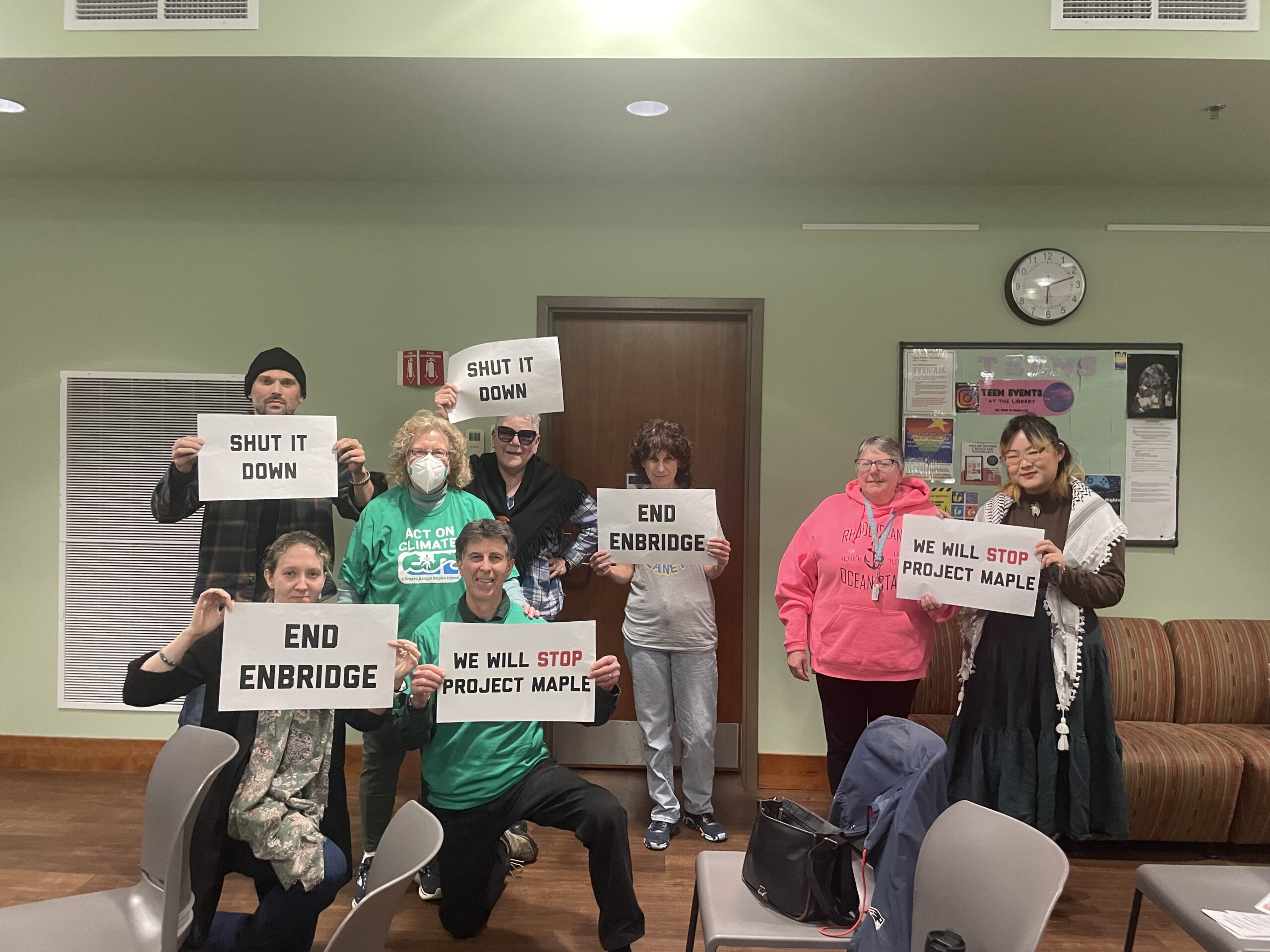
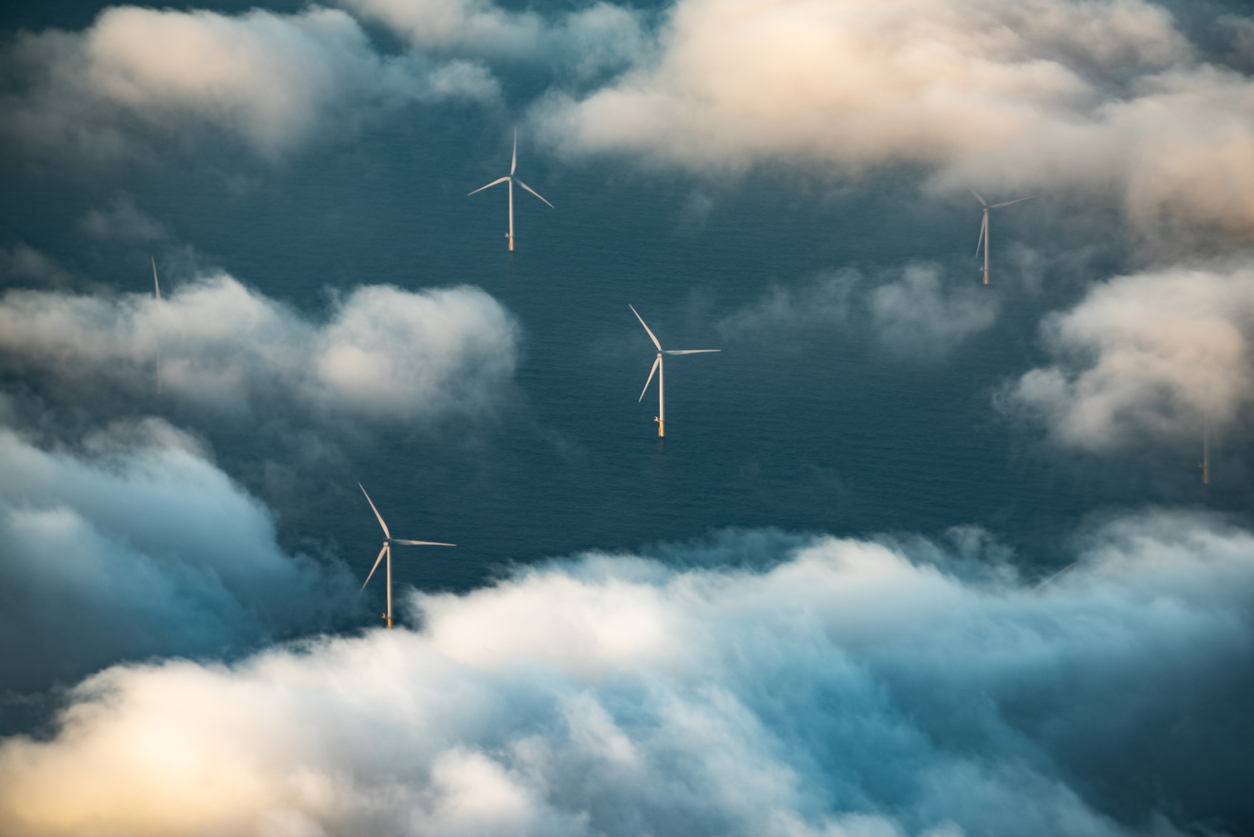
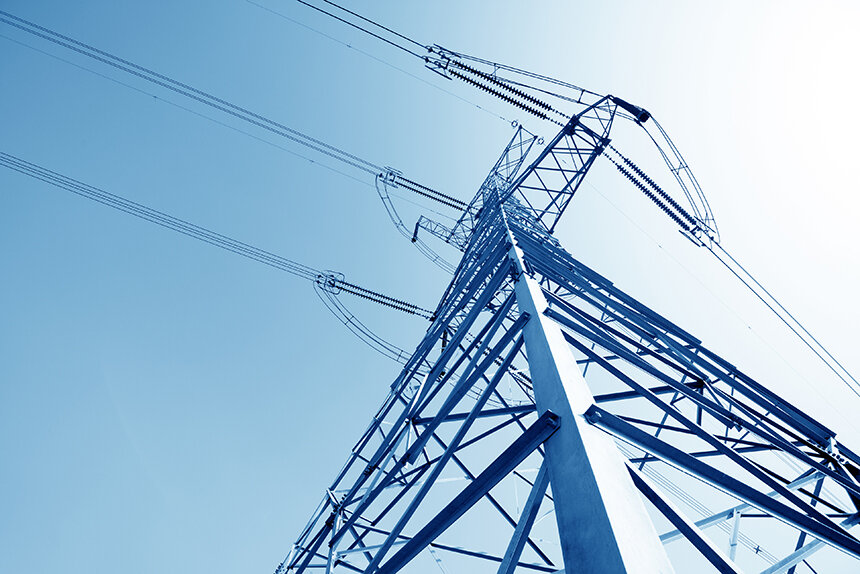
Planned Cable Routes Vs Unplanned Cable Routes
There are alternatives to placing cables through Portsmouth RI
The Portsmouth plan is the unplanned route
The planned routes take the ocean wind power by submarine cable to the large cities and also have the capacity for future wind projects
https://newengland.anbaric.com/
Your article says it is speaking with Fran Haggerty -a protester.
Actually, his name is William Carson.
He is a well-known political operative against wind projects.
He is funded by Koch Industries to spread misinformation far and wide on the internet.
A simple Google search of his name and the search term wind will begin to show his history.